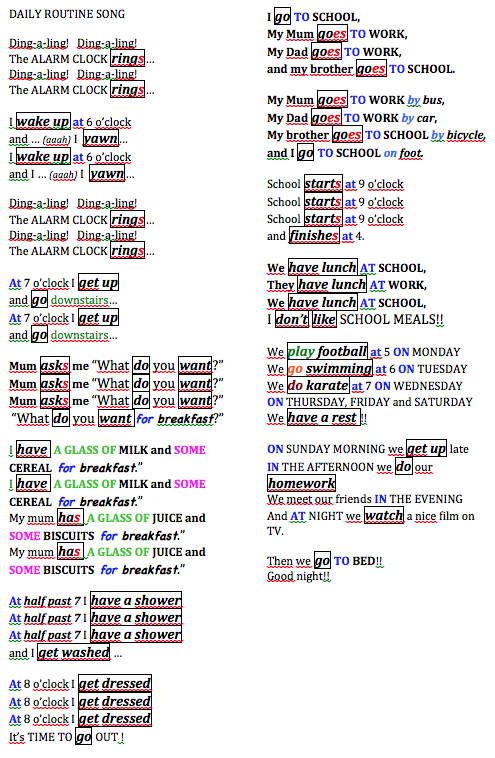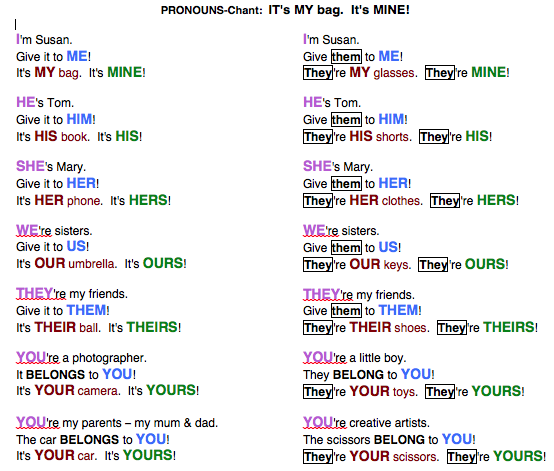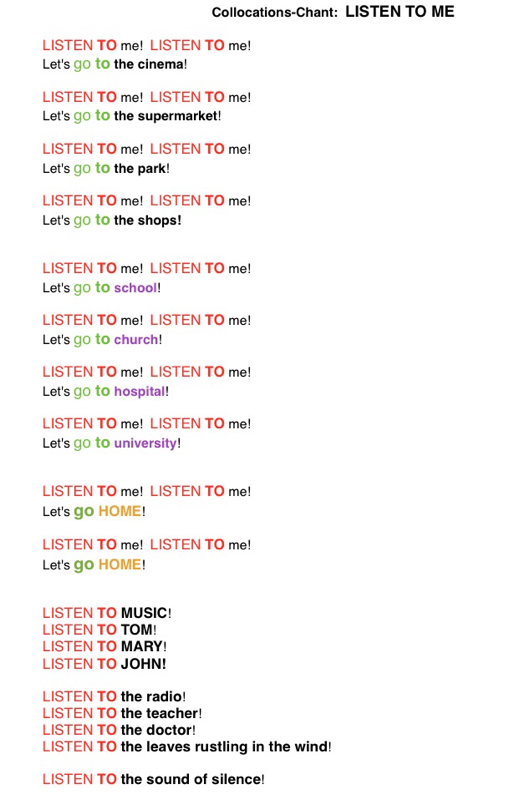|
Many language students tend to dedicate a long time studying rules and doing written exercises yet not many manage to apply them in spontaneous conversation. Despite exposure to texts and listening activities, unless they practise speaking intensively few are talented enough to be able to express themselves orally without sounding unnatural. For this reason I am trying to create useful songs and chants which incorporate repeating collocations, prepositions, phrasal verbs combined with movements to allow students to embed and practise their oral expression in a fun way and lasting manner without feeling bored or embarassed. I believe in 'learning by doing' and practising speaking can never be enough! The following song is about a pupil's DAILY ROUTINE: Download the VIDEO below to see the movements connected to the EXPRESSIONS in the simple song! (Unfortunately I could not upload the Video with subtitles due to 34MB size - I will gladly email it to you on request.) Try it out and have fun! Susan
26 Comments
This second post regarding some of my adventures is not only to encourage students to do likewise, thus practising their writing, but to stimulate people into class discussion on the topics students have written about and shared.
I have always found writing about my personal experiences easier than writing about an imaginary situation which I have never been through. I therefore usually encourage people to base their writing work on something familiar to them and then adapt it to the written assignment making changes where necessary and enriching with adjectives and our imagination. Before having children all my free time was dedicated to globetrotting and I had started writing a book about my travels. Many of those stories are outdated as times change, countries develop... Should anyone like to comment & let me know how things have changed since I visited these countries, it would be welcome feedback. A WEARY TRAVELLER'S TALES Tragicomic Episodes from a Globe-Trotter's Diary As a young, well-travelled globe-trotter, I prefer visiting countries in order to get to know the people, their customs and traditions, rather than only seeing the sights from an air-conditioned bus after having left an anonymous first-class hotel. On my travels I have come across many tragicomic episodes worth recounting, which are not only amusing in themselves but offer a great insight into the ways and being of different peoples in far off countries. The best way to appreciate other mentalities and ways of life is to try and integrate oneself with the people by travelling with local forms of transport, eating in local restaurants and sleeping in hotels where one can mix with the locals rather than with tourists. JAPAN (written in 1990): The Japanese are notoriously clean, leaving their street shoes at the front door. For the uninitiated foreigner this means a lot of practice is needed in slipper changing. Japanese Ryokan are small, but homely hotels in true Japanese style. At the entrance one encounters rows of street shoes neatly lined up under the first step which leads inside. On the step are numerous slippers ready to be donned by anyone who wishes to enter. Once inside these slippers are only to be worn in the halls, never in the rooms, which have 'tatami' mat floors on which one walks in socks or barefoot. Just inside the bathroom, whether private or shared, are other slippers. This means that if I leave my room to use the toilet, I must put on my hall slippers and take them off outside the toilet, because the toilet slippers are just inside. And wo betide the tourist who is caught walking around the hall with the toilet slippers he forgot to slip off again!! * * * Precision is another asset of the Japanese and having lived in Germany, I am quite used to it. However, lining up to catch arriving trains in Japan certainly amazed me. If you buy a ticket with a reservation, you need only to look at the numbered signs along the platform. Besides pointing out where your carriage will stop, the markings on the ground tell you exactly where to stand so you will enter the door which is nearest to your seat number. In fact the train halts exactly with its doors parallel to these markings. This is amazing considering the fact that the Shikansen Bullet Train travels at speeds of up to 250km per hour! * * * In a country like Japan, where a large population is concentrated in a small area, getting away from it all can be most difficult. One Sunday we had the brilliant idea of going to Hakone, a famous national park just outside Tokyo, in order to spend a nice relaxing day next to the mountain lake, hoping to catch a glimpse of Mount Fuji peeking from behind the clouds and carrying a bathing costume to wear in one of the thermal pools of the area. At 8.00 a.m. on a Sunday morning Tokyo station was unusually busy with extra stalls set up to sell "bento"s (packed lunches) and families loaded with small rucksacks hurrying to the trains. Once off the Shinkansen train at Odawara station, we lined up to get our onward tickets. A fifteen minute train ride brought us to Yumoto but by the time we got off, our next train was jam packed and we crammed in to stand like sardines for the half hour trip. At Gora a twenty-minute queue allowed us to get tickets for the cog-wheel train in which we actually sat for the very few minutes it took to get to the top, Souzuno. There we queued for another fifteen minutes in order to catch the longest cable car in Asia. The view was impressive and at the first station we stopped off to see some geysers, which were definitely not worth the time we spent waiting to get back on. At the second station we had intended getting off to bathe in the thermal pools but the staff told us we would never get back on, since no empty cars were coming through. At the top, Togendai was where we found our mountain lake but there seemed to be nowhere to relax. We were not able to enjoy the peacefulness we had been looking forward to because the area was just not peaceful. So we lined up to cross the lake on the red and gold painted boat, camouflaged as an old sailing ship and once finally on it, we tried to relax for the forty minutes we stood on the crowded boat. The lake of volcanic origin was extremely beautiful but at that point we were so stressed that we were unable to enjoy it. Not finding anywhere to sit down and relax because the buses were belching black fumes on the lake front, not having even caught a tiny glimpse of Mount Fuji, we decided to take the bus back down and three-quarters of an hour later we were in Yumoto again. On the short train ride to Odawara, we decided to let everyone else rush home to Tokyo whilst we stopped in this calm, uncrowded town of little interest to have a relaxing meal. * * * .... next episode coming soon! Have you ever had any tragi-comic experiences? Susan I have been setting expressions to music and rhythmic chants for decades with excellent results. Distinguishing when to use the different sets of PRONOUNS and POSSESSIVE ADJECTIVES are always a problem in my classes - students just don’t seem able to distinguish them - so I have invented this chant in the hope of fixing these expressions forever!! Chants are a very repetitive way of embedding expressions in the brain so that they become second-nature and just 'sound right' without having to resort to learning grammar rules and translating from one's own language with the inevitable often horrific results. Taking turns when playing games – many students don’t know when it’s their turn and the others like to ‘wake them up’ but telling them so: I insist they use English, thereby practicing their pronouns at the same time! Here is another chant for them to remember the expression. You can download the worksheets to the chants below. Hope it's useful! Susan
Chants are a very repetitive way of embedding expressions in the brain so that they become second-nature and just 'sound right' without having to resort to learning grammar rules and translating from one's own language with the inevitable often horrific results. I have been setting expressions to music and rhythmic chants for decades with excellent results. LISTEN TO ME. and GO TO are two expressions which are constantly wrong in my classes - students just cannot remember to use the preposition with these verbs - so I have invented this chant in the hope of fixing these expressions forever!! You can download the worksheets to the song below. Hope it's useful! Susan
In constant search for stimulating materials to use with my wide age and level range of students a couple of months ago I stumbled upon THE HISTOMAP which then got lost in my jungle of digital files buried in my computer. It casually reappeared on my screen at the end of the school year and I felt the urge to print and laminate it, sticking it's colourful seven-page vertical length on a column in front of my main entrance door where it is always met with curiosity and fascination. It is the first historical map in my possession which presents 4000 years of history and the relationships between populations in an immediately decipherable context. I have finally come to understand history at a glance! The other day it occurred to me what a potential THE HISTOMAP has for CLIL history lessons but not only... below are just a few ideas which came to mind: - Groups of students prepare questions for other groups using: How long...? Which... ? When... ? - Comparisons can be made: - more powerful than - the most powerful - as... as - New vocabulary, verbs, passive tense and collocations can be introduced: - conquered (by) - reign lasted - were in power for - lasted - weak / strong - great - destroyed (by) - short-lived - long-lived - Western / Eastern world - Middle-East - developed - grew - maintained - people vs population - RESEARCH PROJECTS can be given to youngsters to then present to everyone - ADULTS can tell us anything they know about the various historical periods or populations from personal knowledge. Any other ideas?? You can download THE HISTOMAP below. I found it freely downloadable in Internet .. Hope you find some more stimulating activities to do with it! Susan
Engaging young people in conversation with English-speaking peers not only increases their vocabulary, grammar, fluency, comprehension and confidence but is also much more motivating because they think alike, have similar interests and are usually on the same wave-length.
It is that more beneficial because they pick up and interiorise the language without thinking and translating - the expressions and collocations become "second-nature". At a recent venue abroad a very fluent non-native English speaker kept up a running commentary on the athletic events taking place. However some basic mistakes made it obvious that he was not thinking in English: he wanted to remind the athletes to wear their tracking equipment using the phrase, "Think ON the transponder and number" (in German: Denk AUF...) instead of "Think ABOUT / OF..."; he often repeated, "This is the last lap IN FRONT OF the finish" meaning "the last lap BEFORE the finish", (die letzte Runde VOR dem Ziel). VOR in German means IN FRONT OF as well as BEFORE and if he had learnt them as collocations he would never had made these mistakes! The best way to learn a language is 'living' it in context. The younger the better... The sooner the better... that is why speaking to peers is essential: either for free on various social networks and conversation exchange websites or with paid online lessons which guarantee conversation with serious youngsters who have a wider range of topics to discuss due to their cultural backgrounds and interests which may not only improve a teenager's English but also broaden his horizons. Check out for example CONVERSATION ONLINE for TEENAGERS by a TEENAGER... Another language experience I had in my mother's nursing home in Germany the other day was when all the elderly were sitting watching an event and a German woman SUFFERING FROM obvious DEMENTIA overheard us speaking English and intervened with an excellent accent and correct fluent sentences. This goes to prove that WHEN LANGUAGE IS WELL EMBEDDED IN THE BRAIN THE ELDERLY RETAIN IT even when they are no longer capable of participating in life in the 'present'. Some food for thought! Susan
Actions can be practiced easily with a fun miming game.
I like to introduce more complicated actions like “popping a slice of toast into the toaster” by providing two teams with a list of less commonly known expressions in a fun miming game. In this manner whilst they are trying to guess what the action represents, they are continuously scanning the various new expressions on the list thereby fixing them in their memory and using them to find out if the action corresponds. In fact, as the game progresses they become faster and faster proving that they are learning the expressions at the same time. There are a few rules to follow: 1. Each team receives the same lists (but I usually give three different sheets to each team – one per person – so that everybody is involved in the search since not everyone in each team has the same sheet and so they cannot ‘sleep’ as they have to contribute if their teammates haven’t got the expression they are looking for). 2. The person who is going to mime picks an expression (you have previously cut the expressions into strips) out of a bag. 3. The person miming does so for their own team so that they are forced to do it well. The team members ask: "Are you ....ing?" Answer: "Yes, I am. / No, I'm not." 4. If the team guesses the first time they gain 3 points, if they guess the second time they get 2 points and if they guess the third time they only get one point. 5. If they still haven’t guessed the opposite time gets to try for one point. 6. If they don’t guess the original team has a go for one point and they alternate until one team wins the point. 7. Then the opposing team starts miming again for three points… The game is always very popular and fun as well as being effective. You can download the worksheets below. Feel free to delete or translate the Italian into another language. Hope you have fun with it! Susan |
Categories
All
Would you like regular English learning & teaching ideas? Subscribe to my blog so you don't miss a post!
AuthorMy name is Susan Brodar, born in London into a multilingual family and brought up bilingual English / Italian. Archives
December 2018
|
||||||||||||||||||||||||||||||||||||||||||||||||||||||||||||||||||||||||||||||||||||||||















 RSS Feed
RSS Feed





